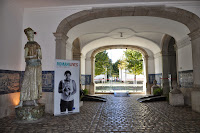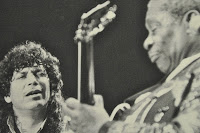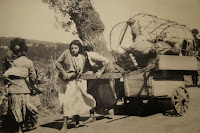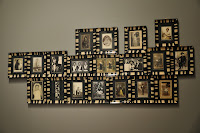Visiting the Lisbon City Museum is interesting enough on any given day be it for the permanent exhibition or the building which houses it but more so this weekend so as to get immersed in the Romani Lives' temporary exhibition being held there.
I must confess that my favourite book as a young girl was "An adventure among Gipsies", whose story I don't recall any more but which definitely allowed me then to "experience" the spirit of freedom I felt I would never be allowed to have, naturally unaware of what they as a community had had to go through and to which extent they had been ostracised.
It wouldn't be much later, whilst reading a book on the second World War, that I started getting a different perspective from the one I had had in my rather "naive" approach as a nine year old child, though the curiosity has always been lingering on and whenever there's some sort of venue related to them I try not to disregard my almost instinct willingness to attend it.
It wouldn't be much later, whilst reading a book on the second World War, that I started getting a different perspective from the one I had had in my rather "naive" approach as a nine year old child, though the curiosity has always been lingering on and whenever there's some sort of venue related to them I try not to disregard my almost instinct willingness to attend it.





Exterior of the Black Pavilion (left). "Lungo Drom" by Rui A. Pereira (2013) marking the entrance to the exhibition.
The exhibition comprises a number of old photos and documentation that provide a fairly interesting historical vision of the presence of gipsies in Iberia since the the fifteenth century through to nowadays.
Royal pragmatic addressed to the gipsies signed by the Catholic King in 1499 and which has been considered by many the beginning of a ferocious persecution.


Gipsy party advertisement -1781 (left). Gipsy Dances -Eighteenth century (right).

Group of gipsies, Andalusia - 1862 - probably the first picture taken of gipsies (left). Two gipsy women with a child outside Porta Real market - 1897 (right).

Portrait of Chorrojumo - 1900 (left). Portrait of the Sacromonte gipsy Anica Antonia, la cambiadora - 1900 (right).

Guadalcanal cattle fair scene, Sevilla - 1920 (left). Gipsy camp during the Guadalcanal cattle fair, Sevilla - 1920 (right).

Photos taken by Jacques Léonard - 1960
Gipsies being expelled from el Pais Basco

Photos taken in 1960



Series of photographs taken by the Portuguese photographer Eduardo Gageiro in Alentejo to the gipsy community - 1980
In 1978 the gipsies were finally recognised as citizens in Spain being officially recognised as having the same rights as any Spanish citizen and thus being allowed to attend school.

Joaquina with her granddaughters

The gipsy guitar player Rafael Amador at the Jazz Festival in Madrid - 1988 (left). Raimundo Amador and B.B. King - 1988 (right).


Photos taken by Miguel Ribeiro Fernandes - 2013

"Latcho Drom" by Rui A. Pereira























No comments:
Post a Comment